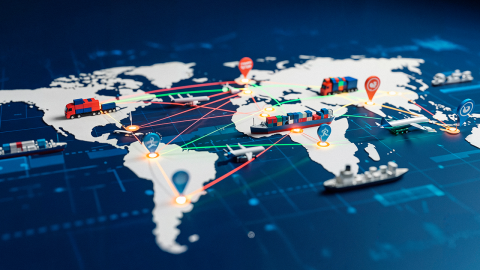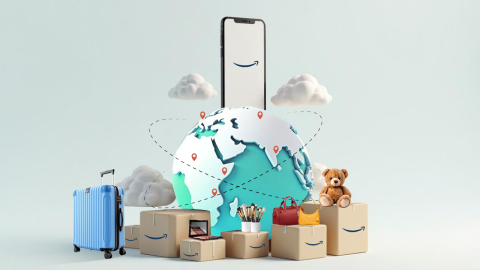Amazon Smbhav 2022 has a power-packed line up of guests who have been part of various engaging sessions. One such was Dr. Anantha Nageswaran, the Chief Economic Adviser to the Government of India, who sat down for a fireside chat with Chetan Krishnaswamy, VP, Public Policy, Amazon India.
Dr. Nageswaran is a multi-faceted person and one of those rare individuals who has had significant experience in the industry, academia, and the government. Even before taking up his role as the Chief Economic Adviser this January, he has been working with the government as a member of the Prime Minister's Economic Advisory Council, while also serving on the board of several companies. Over the years, he has been associated with numerous prominent business schools across the globe. Before this, he had a successful corporate career spanning over 17 years in the financial sector.
Below are excerpts from the chat:
Chetan: Hi, folks. It's a great honor to have Dr. Anantha Nageswaran, the Chief Economic Adviser to the Government of India, with us for this fireside chat. Welcome, Sir. Thank you for accepting the invitation to be a part of Amazon Smbhav 2022. It's indeed my privilege to have him with us today. Let's kickstart our conversation, with most economies reopened and tourism resuming, concerns have largely shifted from the economic impact of the pandemic to the economic impact of Russia's war in Ukraine. As energy and commodity prices soar, rising inflation is a concern around the world. What is the impact you see on India?
Dr. V. Anantha Nageswaran: Chetan, that's a very important and comprehensive question. You are right that the Omicron wave came and went without causing much of a disruption in India, and I think largely elsewhere as well, with the recent exception of China. The feeling was that global economies would continue their recovery from the previous year 2021. And, build on it, gain further momentum, etc. But, within a month of the Omicron variant being in the news, we had the Russia-Ukraine conflict, which broke out towards the end of February. So, the repercussions and the ramifications of it are still kind of filtering through. We may not have even seen all of it yet, because the impact on financial markets and cross-border flows of funds is only now beginning to happen. But it's already had an impact on the price of crude oil. As you know very well, we import more than 80% of our crude from overseas. And to that extent it naturally raises our trade deficit, raises our current account deficit. But more importantly, it raises input costs for all businesses and for households.
The consumption of petrol and diesel is essential and to that extent, therefore it reduces the disposable income for other spending. That's one part of it. The other part of it is that because hydrocarbons are a feedstock for the manufacture of fertilizers- fertilizer prices have begun to shoot up as well and some countries have begun to hoard the fertilizers that they have and imposed bans on fertilizer exports from their countries as well. So, that has contributed directly to a rise in the subsidy that the government of India gives to farmers on fertilizer prices.
Then, of course, despite the inflation impact, the rising price of oil, fertilizer, and also food because Russia and Ukraine are big wheat exporters, while inflation is one aspect of it, food security is another aspect. Thankfully in India, we are relatively far more comfortably placed than others. But there are several countries where the availability of food is more important than even the price. They may be able to get some financial assistance from international organizations and be able to pay for it. But the question is, are they available? Because exports are restricted due to sanctions and seeing that other countries develop a sense of scarcity and hoard what they have. So, I think food availability and food security are going to emerge as a much bigger challenge for several low-income countries around the world.
So, these are all the various and my list is not exhaustive, various ramifications of the Ukraine conflict. But there I would say that compared to other nations, even among advanced countries, I think India is relatively better placed for the simple reason that India paid a certain price last decade because we had banking system stresses, which were then compounded by stress in the non-banking financial sector towards 2018. And then we also had Indian corporates, trimming their balance sheets, and getting their financial health in good shape, etc. So, we are entering into this decade and this conflict in a way with a much better financial system and a much more robust corporate financial health. So that gives us a lot of cushion. And the Reserve Bank of India has ample foreign exchange reserves and with its recent monetary policy move, it has also signaled its determination to combat the inflationary pressures, which is a good thing. It's good for central bank credibility. And as far as the budget is concerned, the government of India did three things in the last three years and more so in this budget as well, which is that the budget is based on very credible assumptions. Both concerning nominal economic growth, and the revenue growth assumptions. And then there is a certain conservatism inbuilt in that. And budget numbers have become more transparent. "What you see is what you get", there is nothing below the budget, and there is no sort of hiding away the government's expenditure in public sector enterprises so that the government's market borrowing looks smaller, it is not that. So, when people comment on, for example, India's market borrowing being much higher it is simply because the government of India isn't trying to hide it in the public sector enterprises' balance sheets, it's now on the government's books. That is the second part.
The third part is seeing that public households are going to be relatively cautious coming out of the Omicron or the COVID mindset to increase their spending. And then corporates will be watching households increase their spending before they commit capital expenditure. The government has taken it upon itself to drive the capital expenditure. And it's important to note here that in 21-22, the revised estimates for capital expenditure are even higher than the budget estimates showing that the government of India has been able to execute its capital expenditure plans made initially in February 2021 even better than what it had envisaged. So, it is on the back of this that the government of India has increased the CAPEX spending for 2022-23 to 7.5 lakh crores, and then you add in the public enterprises spending their CAPEX, state governments being given a one lakh crore 50-year interest-free loan. So, net-net we are targeting something like less than 10 and a half to 11 lakh crores of Capex in the whole country. That gives us a certain growth cushion as well. And the Reserve bank of India is now projecting 7.2% for India's GDP growth, the IMF is projecting 8.2% growth, probably the reality will fall somewhere in between. Whether it falls closer to 8 or closer to 7 would depend on the length of the conflict, the length of period for which the high oil prices rule, and also the peak levels.
We paid our growth dues last decade and we are entering this period with a reasonably comfortable degree of macroeconomic and policy stability.
One silver lining for the oil price, in particular, considering the monetary policy tightening that is happening now in the developed world and considering the lockdown and the economic slowdown in China is that - it is dampening the demand for crude oil. So, on the one hand, we have supply disruptions, but it is being offset by lower demand. So that's in a way, not a bad thing from the Indian point of view, this restraint on the crude oil price. So, all told, I think it is going to be a volatile and turbulent year with a lot of uncertainties. India will not be exempt from that. But I think in the global committee of nations and relatively speaking, India is better placed to handle the fallout because as I told you earlier, we paid our growth dues last decade and we are entering this period with a reasonably comfortable degree of macroeconomic and policy stability.
Chetan Krishnaswamy: Thanks a lot. And you know, that's a fascinating exposition. And the ring of optimism there, you know, cannot be sort of missed.
Dr. V. Anantha Nageswaran: It might sound cliched, but I would say it is cautious and optimistic, both.
Chetan Krishnaswamy: Absolutely. India also appears to be on an FTA signing spree in a bid to diversify its export portfolio. Several of these FTAs contain chapters dedicated to digital trade. What role can the e-commerce sector play to facilitate digital trade and exports?
Dr. V. Anantha Nageswaran: Now let me sort of take this question into two parts. Yes, you are right that the government of India is showing enthusiasm and commitment to concluding free trade agreements. The first thing we should note is that as a country that has a trade deficit by and large with many of its trading partners, India will naturally have more duty concessions to give away in any trade negotiation. That's just a given because you are the one who has more imports and you have an average export-import duty, which is higher than the other partner with whom you're negotiating. Therefore, what you give away is going to be slightly more, but that's a sort of a short-term view.
But what it does is, it lowers the imported landed cost of the products that we import- whether it is primary goods or intermediate goods. So, to that extent, when those goods go into the manufacture of final products in our country- whether it is meant for industrial use or household use- that will lower the overall cost of production. So, it does boost medium-term competitiveness. So, it can be somewhat incorrect to look for immediate benefits in terms of exports. Because when you conclude a free trade agreement, what happens in those countries that already have a very low duty, and when they grant zero duty access for Indian products, we must remember that because they are a low duty country, they already have given zero duty access to many of the other trading partners. All he does is level the playing field for Indian products. Now you must compete on the other dimensions. So that's the part concerning the free trade agreements. And we are negotiating with other countries as well. Besides the two we have just concluded with the UAE and with Australia.
Now, as far as digital trade is concerned, it's obvious that we just need to look at commerce. In general, digital trade or e-commerce is just a manner or method of conducting commerce. Naturally, it makes it relatively easier to reach many far-flung parts of the world. And also for many businesses, even if they are not scale-based, I think the most important contribution that e-commerce does is to take away 'scale' as an impediment. No matter how small you are, no matter how far or how remotely located you are, you're able to participate and be able to access a global market. So, I think we have barely scratched the surface of that.
As India signs free trade agreements, I feel that digitally traded goods and e-commerce platforms will have a very big role to play in boosting our overall exports in the years ahead.
And to the extent that these micro, small, and medium enterprises come on digital platforms or e-commerce platforms, and more importantly, the potential of these free trade agreements is shared with them. They need to be informed; they need to be educated so that they can take advantage of the zero-duty access they have. Then I think, over time, and this will take time to build let's not be under any illusion that it's going to happen overnight. Because in general for India itself, exports will take a long time to react to the free trade agreements initial reaction will be seen in the higher imports. That is okay, that's nothing wrong with it. But over time, Indian products will gain better access as they learn how to compete with other countries. And that is where I think the micro small and medium enterprises will benefit immensely from the access to digital and e-commerce platforms. Therefore, as India signs free trade agreements, I feel that digitally traded goods and e-commerce platforms will have a very big role to play in taking advantage of them and boosting our overall exports in the years ahead.
Chetan Krishnaswamy: Sure, no. And that brings us to this question around the Open Network for Digital Commerce, which is essentially intended to democratize e-commerce. The pilot program is currently underway, and Amazon is very closely engaged with the ONDC team. We're quite fascinated with the thought process there. How do you see ONDC evolving over a period of time, and can also India come up with a unique e-commerce model, with a sort of a win-win situation for both online as well as offline sellers?
Dr. V. Anantha Nageswaran: Absolutely. I think your question contains the elements of the answer I was going to give. Personally, I'm very excited by this development. And in a way as a public policy person also I see this as India sort of playing a pioneering role in creating an open network. I would even call Open Network for Digital Commerce; I will call it Open Network of Democratic Commerce. So that ONDC could be applied in both ways, and it is consistent with what we have done in general with public digital goods, our payments platform, etc.
See in the advanced world, much of these are developed based on private sector initiatives. But that also allows them to erect entry barriers and raise costs for others, obviously to the advantage of their bottom line- which is fine, that is how the marketplace works. But in a country that is a low-income country or aspiring to be a middle-income country in the next decade or so, we need to make sure that we provide access to all citizens to participate in technological advancement.
That is what we have done earlier with mobile phones, one of the lowest carriers in the world. And then we did that with the public digital goods and the payment gateways, which now even for one rupee, you can use your digital payments. And this one also democratizes the e-commerce platforms. And as you said, it blends both brick and mortar businesses and small businesses. I am very excited by the potential it holds. I think, just as we are seeing that UPI is now being adopted by other countries, I do envisage that the ONDC will become the global benchmark in the years ahead. Because the developed world got to where it is today on the back of the Micro, Small and Medium enterprises in their economies. It is not enough to kind of romanticize MSMEs because when you romanticize them, you end up keeping them where they are. But if you believe in them, and their potential to transform the economy- then you have to provide them opportunities to grow out of their humble beginnings. Platforms like ONDC provide exactly the kind of opportunity and more than that, it also means that they will not feel threatened by technology. They will not see this as an either-or, or as a mutually exclusive phenomenon. If they can participate and gain from it, then they will be one of the most welcoming adopters and patrons of new technology. So, in multiple ways, I see this as revolutionizing India's hinterland, revolutionizing India's MSME sector, and e-commerce, and then eventually down the road, making a transformation in the lives of many other developing nations. So I'm very excited about that.
Chetan Krishnaswamy: Switching to, you know, the Prime Minister's grand vision of creating a digitally inclusive India. You know, we have over half a billion internet users in the country today, and the numbers are growing at a phenomenal pace. What according to you should be the key areas of focus for the government in creating a more vibrant digital economy in keeping with the times?
Dr. V. Anantha Nageswaran: I mean, like we discussed in response to your earlier question Chetan, whether it is with respect to digital payment gateways or the ONDC the government is systematically developing the digital ecosystem in the country in multiple dimensions. A crisis like the pandemic has also ended up being opportunities for early adoption, widespread adoption, etc. So, I think already, the groundwork has been pretty strongly laid by this government for developing and expanding the digital ecosystem in the country. But naturally, it's a work in progress. And the key thing, as all of us sort of becoming comfortable with using digital platforms for our payments, for our purchase of goods and services- security becomes the most important thing, and privacy becomes the second most important thing, and the third, I would say is also the infrastructure- the communication network, and the access that we need to have.
If you want to talk about perfect competition, one of the elements of perfect competition is to have a large number of buyers and sellers. What digital commerce platforms do is to enable both- and that is why we must be developing the public platform.
And also, to make sure that any of these, and that is not just confined to digital commerce or digital platforms, in general, you do not want to allow the marketplace to be captured by a few players. If you want to talk about perfect competition, one of the elements of perfect competition is to have a large number of buyers and sellers. What digital commerce platforms do is to enable both- and that is why we must be developing the public platform. It's the foundation on which then the private sector builds the commerce, and the households and consumers participate. So that's a great model because it prevents concentration, it prevents oligopoly, it prevents supernormal profit generation, and it provides an opportunity for both consumers and businesses.
Therefore, whatever we have been doing on the digital ecosystem development is very sound and very advanced. And we just need to keep at it, as long as we sort of make sure that not only we put in place the legal and regulatory framework for data security, for privacy, and also for a level playing field. But more importantly, given that technology evolves rapidly, our regulatory responses also must keep evolving. And these are the ingredients for the successful evolution of a digital ecosystem in the country.
Chetan Krishnaswamy: Time and again, the Prime Minister has called startups the backbone of the Indian economy and the key to realizing an Atmanirbhar Bharat or self-reliant India. Out of the 100 unicorns, only a handful seem to be making profits, many see this as a bubble that will explode. How can India really spawn and nurture this ecosystem?
Dr. V.Anantha Nageswaran: Right. So, I mean, it's a very good question, Chetan. But we need to separate our concerns about the bubble, which is not naturally a concern with respect to their valuations in the financial markets. And we need to separate that from the underlying real phenomena. Let's take the case of the TMT boom in the late 1990s. Or for that matter, the internet boom. Yes, it did lead to bubbles in TMT stocks, it led to a bubble in Internet stocks. We had NASDAQ Composite Index in the US collapse from 5300 to I think, if I'm not mistaken, less than 1000 points back in 2000-2002. But the underlying technology and the advancement that it created didn't die. That is what paved the way for the emergence of companies like yours- Amazon, etc. So I think the bubble part of it is a separate financial market exuberant phenomena that can pop, which will pop, no bubble stays on forever. But the underlying entrepreneurial spirit that this bubble reflects and the willingness of the public to adopt, embrace and use them - that is not going to go away, they will continue. So, he's right in calling the startup unicorns a sign of a different India, a self-confident India that is emerging.
Many engineering colleges and many business schools across the country in B and C towns etc, are now talking of incubators and creating a startup ecosystem.
And also, if you notice, these days, the startup ecosystem is not confined to urban educational institutions, urban residents, or urban youth. Incubators for example, used to be housed only in the IITs and the IIMs. Many engineering colleges and many business schools across the country in B and C towns etc, are now talking of incubators and creating a startup ecosystem. And there was a very good report edited by, I think one of the professors is Rohan Chinchwadkar from IIT, Mumbai. I think they came up with a report on the Indian startup ecosystem and what was very satisfying from a macro and a nation-building point of view was that this culture and the mindset have diffused. So, in that sense, bubbles are something that we see in the financial markets, but the underlying ecosystem is going to sustain and grow. So, therefore, I don't see any contradiction between the two.
Chetan Krishnaswamy: Thank you for taking the time to share your thoughts with us. It's been a pleasure to have you with us at this year's Amazon Smbhav. We truly value your perspectives and insights and have enjoyed listening to your lucid responses.
Dr. V.Anantha Nageswaran: Thank you, Chetan, it was equally my pleasure to converse with you. And I'm very glad that the Smbhav event is going to reach, thanks to the digital presence, more people than who would be able to attend only a physical event. And I'm also very happy to note the amount of contribution that Amazon can make to MSME businesses, onboarding them and allowing them to grow. It has been my pleasure to be part of this event. Thank you.










